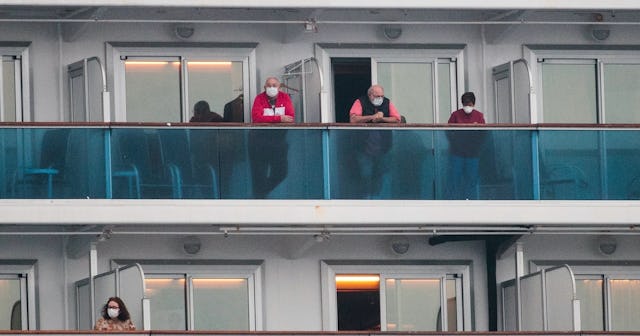14 Americans Evacuated From Cruise Ship Test Positive For Coronavirus

Americans evacuated from quarantined Japanese cruise ship return to U.S. with coronavirus
In early February, news broke that the Japanese cruise ship Diamond Princess had been quarantined after coronavirus was confirmed in multiple passengers. With 3,700 people aboard and climbing numbers of the infection, it remained unclear how long the quarantine would last. However, updates over the weekend reveal that not only has the quarantine been broken, but Americans aboard the ship have also returned to the U.S. — some of whom tested positive for coronavirus.
According to NBC News, approximately 380 American passengers were aboard the Diamond Princess for the duration of the cruise and subsequent quarantine. Of that number, 14 with the coronavirus were flown back to the U.S. after being deemed asymptomatic. An additional 44 Americans from the Diamond Princess who tested positive and are symptomatic will stay in Japan while they recover.
Per the State Department, the American passengers were in the process of being transported off the ship when the organization learned some had coronavirus. “During the evacuation process, after passengers had disembarked the ship and initiated transport to the airport, U.S. officials received notice that 14 passengers, who had been tested two to three days earlier, had tested positive for COVID-19,” the State Department said in a joint statement with the Department of Health and Human Services released on Sunday.
As such, those Americans were separated from the other evacuees and, ultimately, allowed to return to the U.S. — with what the health officials describe as an abundance of caution.
“These individuals were moved in the most expeditious and safe manner to a specialized containment area on the evacuation aircraft to isolate them in accordance with standard protocols,” the joint statement read, referring to the two charter flights that carried the American passengers to military bases in California and Texas over the weekend. “Passengers that develop symptoms in flight and those with positive test results will remain isolated on the flights and will be transported to an appropriate location for continued isolation and care.”
All passengers will have to endure a new 14-day quarantine period.
Why did officials break the cruise ship quarantine and risk the spread of coronavirus in the first place? A top health official addressed the decision on Monday. “As it turned out, [the quarantine] was very ineffective in preventing spread on the ship,” Dr. Anthony Fauci, director of the National Institute of Allergy and Infectious Diseases at the National Institutes of Health, told USA Today.
He continued, “The quarantine process failed. I mean, I’d like to sugarcoat it and try to be diplomatic about it, but it failed. People were getting infected on that ship. Something went awry in the process of the quarantining on that ship. I don’t know what it was, but a lot of people got infected on that ship.”
In fact, health officials in Asia say more than 450 passengers aboard the Diamond Princess have been diagnosed with coronavirus.
Worldwide, around 71,000 cases of the new coronavirus have been reported, spurring the World Health Organization to officially declare it a global public health emergency — this is only the sixth time in the history of the WHO that such a declaration has been made. So far, more than 1,700 people have died due to coronavirus, with the majority of those fatalities taking place in mainland China.
U.S. health officials confirmed the first case of coronavirus in the U.S. in January, when a Washington state man flew home from Wuhan, China, where the outbreak was first reported. A second case soon followed when a Chicago woman was diagnosed with the infection, also after returning from China. The Center for Disease Control continues to monitor cases across the country.
Coronaviruses are a large family of viruses that usually infect animals but can sometimes evolve and spread to humans, which is what’s happening in this current manifestation. Symptoms in humans include fever, coughing, and shortness of breath, which can progress to pneumonia.
So, all of that is the sort of terrifying news. There is a silver lining to the latest update to come from the quarantined cruise ship, though. In a media briefing on Monday, WHO’s general director Dr. Tedros Adhanom Ghebreyesus pointed out that the cruise ship outbreak suggests that COVID-19 is less deadly than other coronaviruses, such as SARS and MERS.
“More than 80 percent of patients have mild disease and will recover,” he explained.